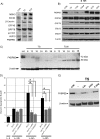Endoplasmic reticulum stress or mutation of an EF-hand Ca(2+)-binding domain directs the FKBP65 rotamase to an ERAD-based proteolysis
- PMID: 21761186
- PMCID: PMC3220392
- DOI: 10.1007/s12192-011-0270-x
Endoplasmic reticulum stress or mutation of an EF-hand Ca(2+)-binding domain directs the FKBP65 rotamase to an ERAD-based proteolysis
Abstract
FKBP65 is an endoplasmic reticulum (ER)-localized chaperone and rotamase, with cargo proteins that include tropoelastin and collagen. In humans, mutations in FKBP65 have recently been shown to cause a form of osteogenesis imperfecta (OI), a brittle bone disease resulting from deficient secretion of mature type I collagen. In this work, we describe the rapid proteolysis of FKBP65 in response to ER stress signals that activate the release of ER Ca(2+) stores. A large-scale screen for stress-induced cellular changes revealed FKBP65 proteins to decrease within 6-12 h of stress activation. Inhibiting IP(3)R-mediated ER Ca(2+) release blocked this response. No other ER-localized chaperone and folding mediators assessed in the study displayed this phenomenon, indicating that this rapid proteolysis of folding mediator is distinctive. Imaging and cellular fractionation confirmed the localization of FKBP65 (72 kDa glycoprotein) to the ER of untreated cells, a rapid decrease in protein levels following ER stress, and the corresponding appearance of a 30-kDa fragment in the cytosol. Inhibition of the proteasome during ER stress revealed an accumulation of FKBP65 in the cytosol, consistent with retrotranslocation and a proteasome-based proteolysis. To assess the role of Ca(2+)-binding EF-hand domains in FKBP65 stability, a recombinant FKBP65-GFP construct was engineered to ablate Ca(2+) binding at each of two EF-hand domains. Cells transfected with the wild-type construct displayed ER localization of the FKBP65-GFP protein and a proteasome-dependent proteolysis in response to ER stress. Recombinant FKBP65-GFP carrying a defect in the EF1 Ca(2+)-binding domain displayed diminished protein in the ER when compared to wild-type FKBP65-GFP. Proteasome inhibition restored mutant protein to levels similar to that of the wild-type FKBP65-GFP. A similar mutation in EF2 did not confer FKBP65 proteolysis. This work supports a model in which stress-induced changes in ER Ca(2+) stores induce the rapid proteolysis of FKBP65, a chaperone and folding mediator of collagen and tropoelastin. The destruction of this protein may identify a cellular strategy for replacement of protein folding machinery following ER stress. The implications for stress-induced changes in the handling of aggregate-prone proteins in the ER-Golgi secretory pathway are discussed. This work was supported by grants from the National Institutes of Health (R15GM065139) and the National Science Foundation (DBI-0452587).
Figures







Similar articles
-
Developmental regulation and coordinate reexpression of FKBP65 with extracellular matrix proteins after lung injury suggest a specialized function for this endoplasmic reticulum immunophilin.Cell Stress Chaperones. 2005 Winter;10(4):285-95. doi: 10.1379/csc-118r.1. Cell Stress Chaperones. 2005. PMID: 16333983 Free PMC article.
-
Heat shock protein 47 and 65-kDa FK506-binding protein weakly but synergistically interact during collagen folding in the endoplasmic reticulum.J Biol Chem. 2017 Oct 20;292(42):17216-17224. doi: 10.1074/jbc.M117.802298. Epub 2017 Aug 31. J Biol Chem. 2017. PMID: 28860186 Free PMC article.
-
Developmental regulation of FKBP65. An ER-localized extracellular matrix binding-protein.Mol Biol Cell. 2000 Nov;11(11):3925-35. doi: 10.1091/mbc.11.11.3925. Mol Biol Cell. 2000. PMID: 11071917 Free PMC article.
-
Toxins Utilize the Endoplasmic Reticulum-Associated Protein Degradation Pathway in Their Intoxication Process.Int J Mol Sci. 2019 Mar 15;20(6):1307. doi: 10.3390/ijms20061307. Int J Mol Sci. 2019. PMID: 30875878 Free PMC article. Review.
-
Roles of the endoplasmic reticulum-resident, collagen-specific molecular chaperone Hsp47 in vertebrate cells and human disease.J Biol Chem. 2019 Feb 8;294(6):2133-2141. doi: 10.1074/jbc.TM118.002812. Epub 2018 Dec 12. J Biol Chem. 2019. PMID: 30541925 Free PMC article. Review.
Cited by
-
Genetic Analysis and Functional Study of a Pedigree With Bruck Syndrome Caused by PLOD2 Variant.Front Pediatr. 2022 May 6;10:878172. doi: 10.3389/fped.2022.878172. eCollection 2022. Front Pediatr. 2022. PMID: 35601416 Free PMC article.
-
FK506-Binding Protein 10, a Potential Novel Drug Target for Idiopathic Pulmonary Fibrosis.Am J Respir Crit Care Med. 2015 Aug 15;192(4):455-67. doi: 10.1164/rccm.201412-2233OC. Am J Respir Crit Care Med. 2015. PMID: 26039104 Free PMC article.
-
Novel mutations in FKBP10 in Chinese patients with osteogenesis imperfecta and their treatment with zoledronic acid.J Hum Genet. 2017 Feb;62(2):205-211. doi: 10.1038/jhg.2016.109. Epub 2016 Aug 25. J Hum Genet. 2017. PMID: 27762305
-
Identification of PP1-Gadd34 substrates involved in the unfolded protein response using K-BIPS, a method for phosphatase substrate identification.Mol Omics. 2018 Apr 16;14(2):121-133. doi: 10.1039/c7mo00064b. Mol Omics. 2018. PMID: 29623310 Free PMC article.
-
Pharmacological and biological therapeutic strategies for osteogenesis imperfecta.Am J Med Genet C Semin Med Genet. 2016 Dec;172(4):367-383. doi: 10.1002/ajmg.c.31532. Epub 2016 Nov 3. Am J Med Genet C Semin Med Genet. 2016. PMID: 27813341 Free PMC article. Review.
References
-
- Brewster JL, Linseman DA, Bouchard RJ, Loucks FA, Precht TA, Esch EA, Heidenreich KA. Endoplasmic reticulum stress and trophic factor withdrawal activate distinct signaling cascades that induce glycogen synthase kinase 3beta and a caspase-9-dependent apoptosis in cerebellar granule neurons. Mol Cell Neurosci. 2006;32:242–253. doi: 10.1016/j.mcn.2006.04.006. - DOI - PubMed
Publication types
MeSH terms
Substances
Grants and funding
LinkOut - more resources
Full Text Sources
Miscellaneous

